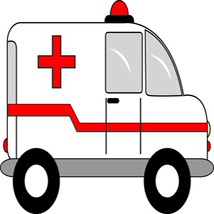
STARofLIFE
Union County, NJ
Male, 24
I have been a certified Emergency Medical Technician (E.M.T.) for over 6 years. I am the true "first responder" and have been dispatched to over 1,000 calls including medical, trauma, and psychiatric emergencies. How do I handle the stress and what goes on in my mind when YOUR life is on the line? Find out by asking me anything!
First off, this policy varies by organization. State law requires at minimum a certified EMT and a certified EVOC (emergency vehicle operations course) driver per ambulance. My squad requires at least TWO state certified EMT who are also EVOC certified per crew. Thus, both members are able to provide medical care and drive the ambulance. To answer your question, I can either drive the ambulance or provide patient care. Usually, my partner and I will simply take turns driving. We alternate. There is often a "probationary" member who is either certified or not certified. This member just observes and acts as an extra pair of hands to help lift the patient and transport equipment. The idea is that this "probationary" member will become a regular member after receiving state certification and passing the squad's training program.
Legally, every person riding in the ambulance must have a seat belt. This means that we technically have capacity for 5 more people besides the treating EMT and patient. We have no official policy on how many chaperons can ride along. However, we usually just allow one extra person to keep things simple. When we deal with special populations (kids or psychiatric patients), we usually allow two or more chaperones to take the ride. I have never had any serious drama or fights with a person who wanted to ride but was not allowed to.
Luckily, this has never happened to me. However, when it does happen, the consequences tend to be grave. The fact that ambulances run red lights and disobey the rules of the road make driving an ambulance a very difficult task. I encourage everyone who is reading this to PLEASE pull over for an ambulance, fire truck or police car even if the vehicle is on the other side of the road. You wouldn't believe how many cars won't yield to me! It's dangerous and drives me crazy. I actually responded to an ambulance accident once, which is ironic. A car in front of the ambulance stopped short and because of momentum, a small fender bender occurred. Fortunately, no one was hurt. We transported the original patient to the hospital.
Good question. This problem is unfortunately much more common in society now-a-days (the obesity rate rose in EVERY SINGLE STATE last year with a few states having around 30% of their population qualifying as obese). Our squad just purchased new, electronic stretchers that can accommodate up to 700 pounds. Now, I'm not exactly sure if a 700 lb. person can fit in the ambulance. I'd guess that would be quite difficult. I would guess that the biggest person we could transport in the ambulance comfortably would be about 500 pounds. Again, just a guess. Now if we had an emergency for a 700 lb. person, we would be calling the fire department for a lift assist. This is often an important role for firemen. When we need "muscle" for heavy lifting jobs, we call our fire department. If we needed to transport a 700 lb. man and he couldn't fit in the ambulance. I would think that we could try to transport him in the fire truck. This vehicle has much more room.
Private Detective
Call Center Employee (Retail)
 Do you think it's just a matter of time before all U.S. companies move their customer support overseas?
Do you think it's just a matter of time before all U.S. companies move their customer support overseas?
Professional Gamer
 What's the longest playing gaming session you've ever had?
What's the longest playing gaming session you've ever had?
I have never had a patient die in front of me. I have, however, responded to patients who are DOA (dead on arrival). This has only happened a few times to me and each time I was responding to a nursing home. Each person deals with death as an EMT differently. However, if the situation was particularly traumatic of difficult (death of child) we are required to attend a small group counseling session. Personally, I am not bothered by these types of situations.
While it is tempting, I have never done this. I would imagine we would get in trouble with the police. Interestingly, there are no rules on when you should or shouldn't use the siren. Many times if I am transporting a patient who is not having an acute medical emergency, I will drive to the hospital without lights or sirens. Driving with lights and sirens is the most dangerous thing I do as an EMT. While it is fun and exciting, I care more about transporting my patient and my crew to the hospital as safely and securely as possible. Furthermore, when responding to psychiatric emergencies, we do not use the lights and sirens as to not agitate or scare the patient. One time, after picking up food, I accidentally turned the emergency lights on without knowing it. I was confused as to why the cars in front of me were all pulling over. I then realized what I had done and quickly shut them off. This was during the daytime when its hard to see the lights from inside the ambulance.
Yes, we treat anyone and everyone. We are a volunteer squad and run entirely off of tax-deductible donations. The real issue is with the MICU (Mobile Intensive Care Unit) Paramedics. These are emergency health care providers who are dispatched by the hospital and can provide a much greater level of care than the EMT. As soon as the Paramedics begin an examination, a large bill (around $1,000) is generated. Now, Paramedics would never deny treatment based on insurance needs in the field. To the best of my knowledge, the patient is billed and must pay out of pocket. The patient could apply for charity care or work something else out.
-OR-
 Login with Facebook
Login with Facebook (max 20 characters - letters, numbers, and underscores only. Note that your username is private, and you have the option to choose an alias when asking questions or hosting a Q&A.)
(A valid e-mail address is required. Your e-mail will not be shared with anyone.)
(min 5 characters)
By checking this box, you acknowledge that you have read and agree to Jobstr.com’s Terms and Privacy Policy.
-OR-
 Register with Facebook
Register with Facebook(Don't worry: you'll be able to choose an alias when asking questions or hosting a Q&A.)